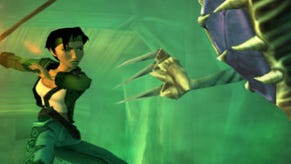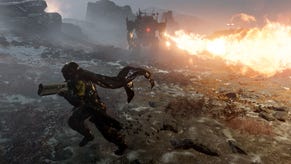I can move any mountain: From Dust hands-on
A recent hands-on with Ubisoft’s From Dust saw VG247 turn divine creator, and, in the name of charity and good will, shepherd the weak through the valley of darkness. Hands-on impressions.
Games are designed to empower us; many grant us abilities beyond our ken, making us feel like gods.
Some charge us with protecting those more vulnerable than ourselves, casting us in the role of disembodied shepherd with dominion over the environment. Over the years, those that have done this successfully are fondly remembered: Populous, Black and White, Lemmings and Dungeon Keeper. Few others have matched these games for granting near omnipotence whilst being able to induce a feeling helpless panic as the best laid plans begin to unravel. They taught us that, whilst we may play as gods, we are still eminently fallible.
Conceived by Eric Chahi, Ubisoft Montpellier’s upcoming From Dust looks set to evoke this feeling in us once more. The game’s central mechanic, of facilitating the expansion and exodus of a nomadic tribe, is a finely balanced challenge of choice versus consequence, immediacy versus permanence and planning versus experimentation, with multiple possible solutions to numerous environmental conundrums.
Five: That’s the magic number
Each level consists of a number of totem poles that must be reached by five members of the tribe so that they can create a semi-permanent village waypoint. The villages will remain established around the totem pole unless destroyed by some form of natural disaster or, occasionally, by your own carelessness as you re-sculpt the island.
The eventual goal of each level must also be reached five tribesmen - villages are capable of respawning lost tribesmen and, so long as you still have five of them alive, tribesmen can rebuild lost villages. Lose all of your villages when you have less than five followers and it’s game over.
Our hands-on starts gently enough as we instruct our small tribe to cross a shallow river by highlighting the totem on the far side of the bank. An ephemeral white line shows the path that they will take in their attempt to reach their destination and where environmental obstacles make further progress temporarily impossible the line turns red, indicating that your attention is required.
Being a god, it is within your power to make the impossible possible and so, with a squeeze of the left trigger, you can choose either to attempt to drain the river - gathering the water into a swirling ball about the cursor which forms your only tangible presence in the game world - or create a makeshift bridge.
Being a god, it is within your power to make the impossible possible.
It’s here that the construct of immediacy versus permanence first shows itself: draining the river requires it to first be blocked off or diverted at source, whereas creating a bridge can be achieved by scooping up sand and piling it in the narrow river. Being made of sand, the makeshift bridge will eventually wash away but with your tribesmen standing ready to cross it serves its purpose and, in what will become a key consideration with later obstacles, doesn’t change the structure of the island.
Potentially lethal environmental catastrophes such as tsunamis and volcanic eruptions are foreseen in advance and because you cannot prevent them from occurring, you must find a way to nullify their effects. One such event sees the waves of a tsunami periodically crashing against a range of rocky spires, the fluid waves finding gaps between the tall rocks and flooding a basin in which the second of our totem waypoints is found. Fortunately, your followers will stay put at the last created waypoint until such time that you highlight their next destination, so they’re are safe enough while you plan the next move.
Exploration of the island from your lofty vantage point reveals a special collectible which will grant protection from the ceaseless tsunami waves, but capturing the power-up requires traversal of a hazardous terrain beset by lava flow on one side and the wide expanse of a sea-fed river on the other.
However, an alternative option for shoring up the totem is available. Gathering up lava from the volcano it can be carefully oozed between the fingers of rock, solidifying as it cools and creating a natural barrier against the ferocity of the tsunami. Zooming in with the camera facilitates this delicate endeavour and it’s one of the few times during the hands-on that the extra precision of a mouse would be welcome.
Planning is all good and well but it’s only by experimenting and then patiently waiting until the next wave hits that you can see whether you’ve successfully plugged all of the gaps and if it’s safe to move your dependents onwards to establish their second village.
Multi-tasking
When you have only one thing to deal with at a time the pace remains sedate, but as the level progresses and multiple threats must be dealt with in quick succession to allow your tribesmen to negotiate long stretches of hazardous terrain, the game quickens the heart.
The further you progress into the level the more likely it is that the longer term consequences of earlier choices will begin to reveal themselves. Diverting a river might have helped solve one problem but you may find you’ve hindered your own progress by creating a flood plain somewhere else or perhaps an even more powerful river fed by multiple tributaries. Similarly, crafting a bridge from cooled magma will not be eroded so easily as a sandbank, thus giving your tribe more time to cross it, but it might also act as a dam, forcing the water or lava into other outlets - outlets that might endanger earlier established village waypoints.
In this way, From Dust forces you to consider how your actions affect the whole level, not just the individual obstacle you’re trying to solve at the time. Later puzzles require you to establish a permanent source of water to feed barren sandy valleys in order for vegetation to grow so that your charges can hunt and feed themselves. Converting a high enough percentage of the land from dusty brown to verdant green unlocks story events and hidden rewards.
Godly powers are unlocked, imbuing you with the ability to temporarily jellify water that can be scooped out or built upon, as well as the power to evaporate all of the water in the level so your tribes-people can traverse a wide stretch of river bed. Tapping the left bumper zooms the camera to focus on a specific tribesman so you can watch as they clamber across obstacles via your meticulously planned or flash-of-genius solutions.
From Dust may carve out a place alongside other fondly remembered greats
As an XBLA, PSN and PC download title there From Dust may not receive the attention or publicity that it appears to warrant. Its unmanned demo pod at a recent Ubisoft press day, overshadowed by the noisy bank of consoles running Assassin’s Creed Revelations nearby, made for a worrying image of its potential to be lost amongst the hubbub. Happily, bolstering its chance for commercial success is its presence in the XBLA Summer of Arcade promotion and, from impressions gleaned during our hands-on time, it should review positively ahead of its launch on July 27.
God games have fallen from grace over the course of the last decade but From Dust’s style and substance could reignite interest in the genre. By offering you the creative ability to sculpt worlds it may carve out a place for itself alongside those other fondly remembered greats.
From Dust launches on XBLA on 27 July, PC on August 17 and PSN later in the year


















